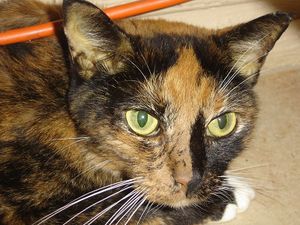Difference between revisions of "Bilirubin"
| Line 1: | Line 1: | ||
| + | [[File:Jaundiced cat.jpg|thumb|right|Image of a jaundiced cat, note the discoloured pinnae<br><small>(Image source Sabar 2007, Wikimedia Commons)</small>]] | ||
==Description== | ==Description== | ||
Bilirubin is a pigment formed from the haem groups of haemoglobin molecules. The enzymatic conversion occurs within cells of the monocyte-phagocyte system (MPS) when haemoglobin is released by the degradation of red blood cells. This '''unconjugated''' bilirubin is not water soluble and it is transported in plasma bound to albumin. It is taken up into hepatocytes where it is conjugated with glucuronic acid. The resultant '''conjugated''' bilirubin is water soluble and it is secreted into bile which then moves into the small intestine. Unconjugated bilirubin is sometimes referred to as direct, in contrast to unconjugated which can be referred to as indirect bilirubin. | Bilirubin is a pigment formed from the haem groups of haemoglobin molecules. The enzymatic conversion occurs within cells of the monocyte-phagocyte system (MPS) when haemoglobin is released by the degradation of red blood cells. This '''unconjugated''' bilirubin is not water soluble and it is transported in plasma bound to albumin. It is taken up into hepatocytes where it is conjugated with glucuronic acid. The resultant '''conjugated''' bilirubin is water soluble and it is secreted into bile which then moves into the small intestine. Unconjugated bilirubin is sometimes referred to as direct, in contrast to unconjugated which can be referred to as indirect bilirubin. | ||
Revision as of 19:33, 3 November 2010
Description
Bilirubin is a pigment formed from the haem groups of haemoglobin molecules. The enzymatic conversion occurs within cells of the monocyte-phagocyte system (MPS) when haemoglobin is released by the degradation of red blood cells. This unconjugated bilirubin is not water soluble and it is transported in plasma bound to albumin. It is taken up into hepatocytes where it is conjugated with glucuronic acid. The resultant conjugated bilirubin is water soluble and it is secreted into bile which then moves into the small intestine. Unconjugated bilirubin is sometimes referred to as direct, in contrast to unconjugated which can be referred to as indirect bilirubin.
The conjugated bilirubin is degraded to urobilinogen by gastro-intestinal bacteria and a small proportion of this product is reabsorbed and excreted in the urine. The remaining urobilinogen is further degraded to stercobilin, a brown pigment which contributes to the colour of faeces. Therefore, in animals with complete biliary obstruction, urobilinogen is absent from the urine and the faeces have a white/grey 'alcoholic' colour due to the absence of stercobilin. The latter alteration in faecal colour also results from steatorrhoea.
Small quantities of conjugated bilirubin are found in the urine of normal dogs because it has a low renal threshold.
The technical name for Jaundice is Icterus, which refers to the staining of tissues by bilirubin pigment or bilirubin complexes, a phenomenon that is clinically evident on physical examination of the sclera and mucous membranes. It can also been seen on a separated blood sample - the serum will appear yellow/orange in colour.
Hyperbilirubinaemia
Bilirubin increases when the production of bilirubin exceeds the ability of the liver to recover unconjugated bilirubin from the bloodstream and process it, or when clearance of the conjugated form is altered by impaired hepatocyte processes or obstruction to the discharge of bilirubin into the intestines. Clinically, this means that hyperbilirubinaemia can be cased by heamolysis or choleostasis - the next step diagnostically is to establish if the inciting cause is prehepatic, hepatic or posthepatic.
Bilirubin in horses
Horses have a different biliary excretion system to other animals and also readily develop jaundice in response to anorexia, so hyperbilirubinaemia can be difficult to interpret in the horse and elevated unconjugated bilirubin levels in the absence of any clinical signs might be of little consequence.
Distinguishing Conjugated from Unconjugated Bilirubin
The Van de Berg test can be used to distinguish conjugated from unconjugated bilirubin. Plasma from an icteric animal is treated with an aqueous solution of the reagent diazotised sulphanilic acid and this produces a red-purple colour reaction. The intensity of this colour is directly proportional to the amount of water soluble (conjugated ) bilirubin in the sample. Further addition of alcohol intensifies the colour if there is non-water soluble (unconjugated) bilirubin also present. The intensified colour is directly proportional to the total amount of bilirubin present in the sample and the difference between the two readings gives the amount of unconjugated bilirubin in the sample.
